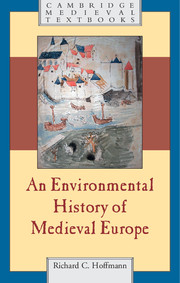Book contents
- Frontmatter
- Contents
- List of figures
- List of maps
- Preface
- Frontispiece: Nature and culture at Waterford, Ireland, 1372
- Introduction: Thinking about medieval Europeans in their natural world
- 1 Long no wilderness
- 2 Intersecting instabilities: culture and nature at medieval beginnings, c.400–900
- 3 Humankind and God’s Creation in medieval minds
- 4 Medieval land use and the formation of traditional European landscapes
- 5 Medieval use, management, and sustainability of local ecosystems, 1: primary biological production sectors
- 6 Medieval Use, management, and sustainability of local ecosystems, 2: interactions with the non-living environment
- 7 ‘This belongs to me . . .’
- 8 Suffering the uncomprehended: disease as a natural agent
- 9 An inconstant planet, seen and unseen, under foot and overhead
- 10 A slow end of medieval environmental relations
- Afterword
- A sampler for further reading
- Index
6 - Medieval Use, management, and sustainability of local ecosystems, 2: interactions with the non-living environment
Published online by Cambridge University Press: 05 July 2014
- Frontmatter
- Contents
- List of figures
- List of maps
- Preface
- Frontispiece: Nature and culture at Waterford, Ireland, 1372
- Introduction: Thinking about medieval Europeans in their natural world
- 1 Long no wilderness
- 2 Intersecting instabilities: culture and nature at medieval beginnings, c.400–900
- 3 Humankind and God’s Creation in medieval minds
- 4 Medieval land use and the formation of traditional European landscapes
- 5 Medieval use, management, and sustainability of local ecosystems, 1: primary biological production sectors
- 6 Medieval Use, management, and sustainability of local ecosystems, 2: interactions with the non-living environment
- 7 ‘This belongs to me . . .’
- 8 Suffering the uncomprehended: disease as a natural agent
- 9 An inconstant planet, seen and unseen, under foot and overhead
- 10 A slow end of medieval environmental relations
- Afterword
- A sampler for further reading
- Index
Summary
From medieval colonization of primary biological production in agriculture, woodlands, and other biota, this chapter turns to human use and sustainability of mainly non-living parts of the environment. It begins with closer study of the energy basis for all medieval society. There follow issues related to inorganic material resources, particularly mining and metallurgy, and then the wholly anthropogenic artificial ecosystems that were medieval cities. Having observed metabolic flows throughout, the chapter closes with provisional consideration of how well such concepts as sustainability, ecological overshoot, and collapse capture medieval Europeans’ experience of the world around them.
The energy basis for medieval society
By present-day standards medieval Europe, like all pre-industrial societies, was a low-energy civilization. Energy was costly and always in short supply. A pre-industrial society cannot do as twentieth-century industrial societies became accustomed to do and pour cheap and abundant energy on their intractable problems. Expending energy was not the first option and oftentimes not even the last. Energy was sparse; it had to be hoarded.
- Type
- Chapter
- Information
- An Environmental History of Medieval Europe , pp. 196 - 240Publisher: Cambridge University PressPrint publication year: 2014



